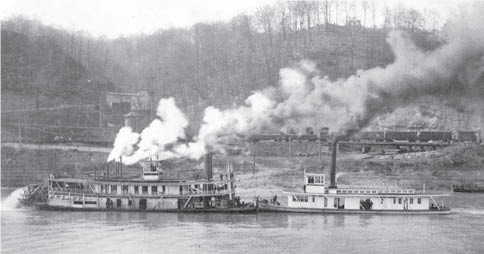In 1903, the Charles Ward Engineering Company of Charleston, W.Va., constructed a twin-propeller steam towboat named James Rumsey for the U.S. Army Corps of Engineers at Wheeling, W.Va.
Built on a steel hull measuring 119.6 feet in length by 22 feet in width, the vessel had quadruple expansion condensing engines rated at 425 hp. One boiler, a sectional water tube type, supplied the steam. Reportedly, the Ward firm boasted widely that the new Rumsey was the wave of the future and could accomplish great things with half the coal consumption of a sternwheeler and with one third fewer crew members. Rivermen debated the ballyhooing, and a shoving contest was ultimately arranged.
The Society of Naval Architects and Marine Engineers held a meeting in June 1909 at Detroit, Mich., at which the 1903 event was recounted by Ward: “The Rumsey, of 120 tons, challenged the steamer D.T. Lane, of 350 tons and 450 hp., to a pushing and backing contest, the Rumsey agreeing to push the D.T. Lane upstream against its full power. A time was fixed and announced; thousands lined the river bank, windows and housetops; the two boats were lashed head to head and at a signal the contest began with both boats pushing at each other with all their might and power. The D.T. Lane, for a second, seemed to gain slightly on the Rumsey. But, gradually, the Rumsey held it back and pushed the Lane upstream against the sternwheeler’s full power, a strong current and a downstream wind. The two boats then changed position, with regard to the stream, when the Rumsey backed upstream, quite easily overcoming both the full power of the D.T. Lane and the current against it, thus demonstrating the superiority of modern engineering and the supremacy of the new type of boat.”
According to Capt. Fred Way, nothing definite was ever decided, but it remained a hot topic amongst river people, akin to the race between the Natchez and Robt. E. Lee.
Under the command of Capt. Earl Barrows, the Rumsey was the first boat through the new Marmet Lock on the Kanawha River in the fall of 1932. The towboat was sold in 1934 to the Louisville Sand & Gravel Company and renamed Steve Click Jr. The boat sank in the Louisville & Portland Canal in 1936, but was raised and repaired in three weeks.
Sold to Jesse Cooper, of Helena, Ark., in 1946, the vessel again sank in 1947 and was a total loss.
The D.T. Lane
Built at Pittsburgh in 1871 on a wooden hull measuring 129.6 feet in length by 24.1 feet in width, the boat was named for David T. Lane, who owned a hotel at Haysville, Pa. Three boilers provided steam to engines (16-inch cylinders with 5.5 foot stroke) recycled from the sidewheel packet Ingomar.
The boat changed owners several times, was rebuilt at Covington, Ky., in 1880 and primarily used for towing coal on the Kanawha River. The riverboat was dismantled at Dana, W.Va., in 1908. The hull and cabin were destroyed by fire but the engines were salvaged for use on the second D.T. Lane.
More on this towboat will be presented in a future Old Boat Column.
Editor’s note: For questions or suggestions regarding the Old Boat Column, Keith Norrington may be contacted by e-mail at curatorkeith@yahoo.com, or by mail through the Howard Steamboat Museum at P.O. Box 606, Jeffersonville, Ind. 47131-0606.




